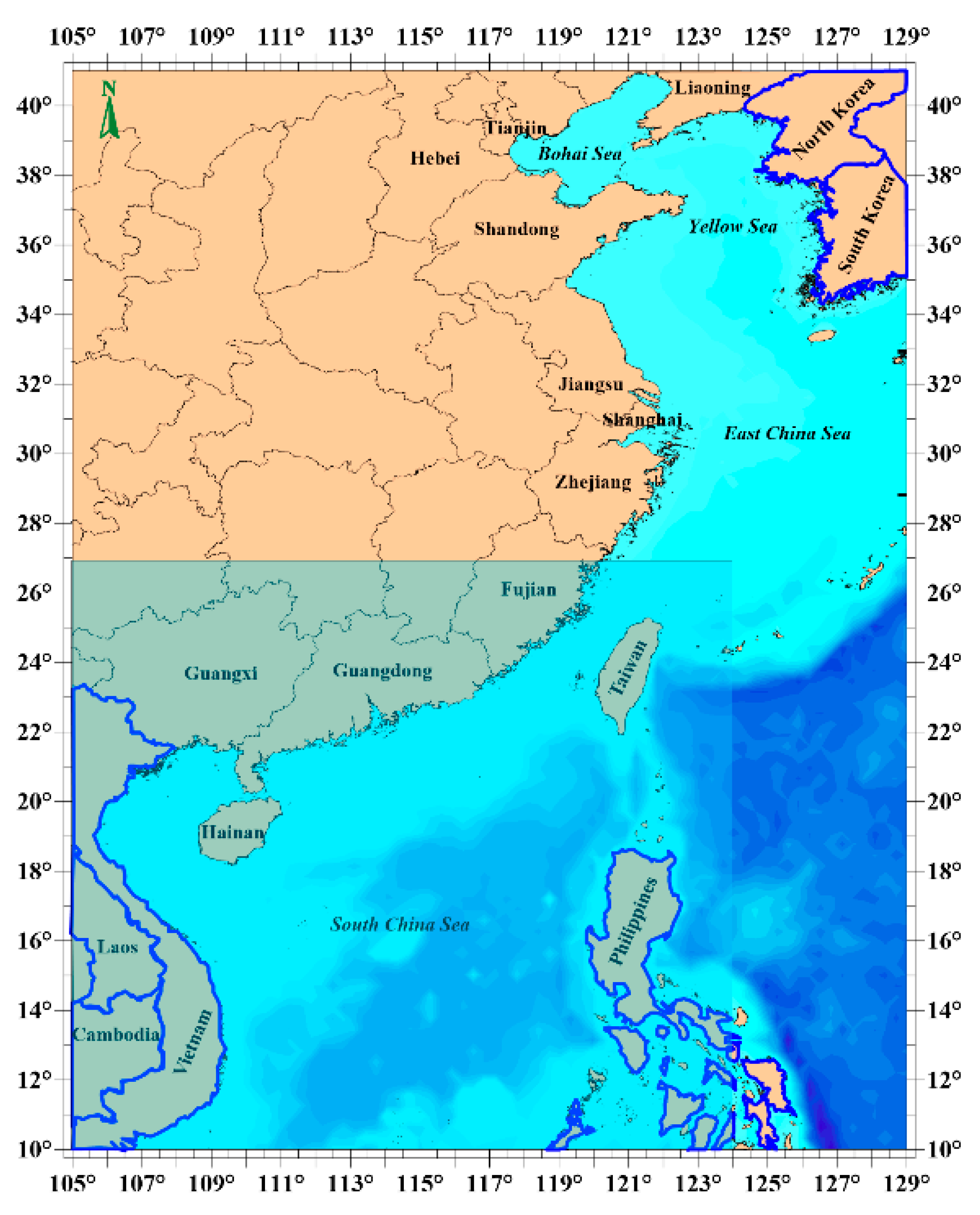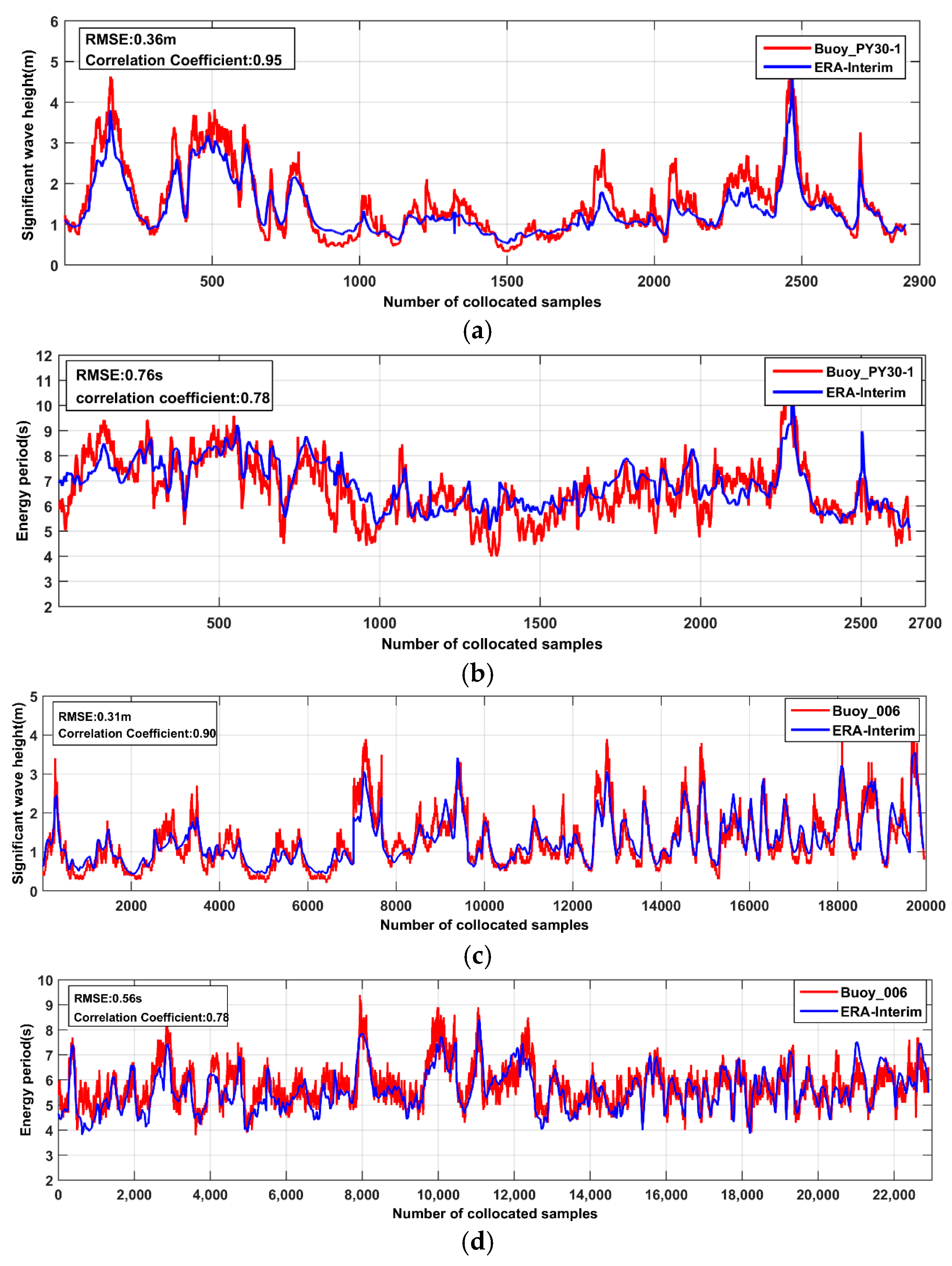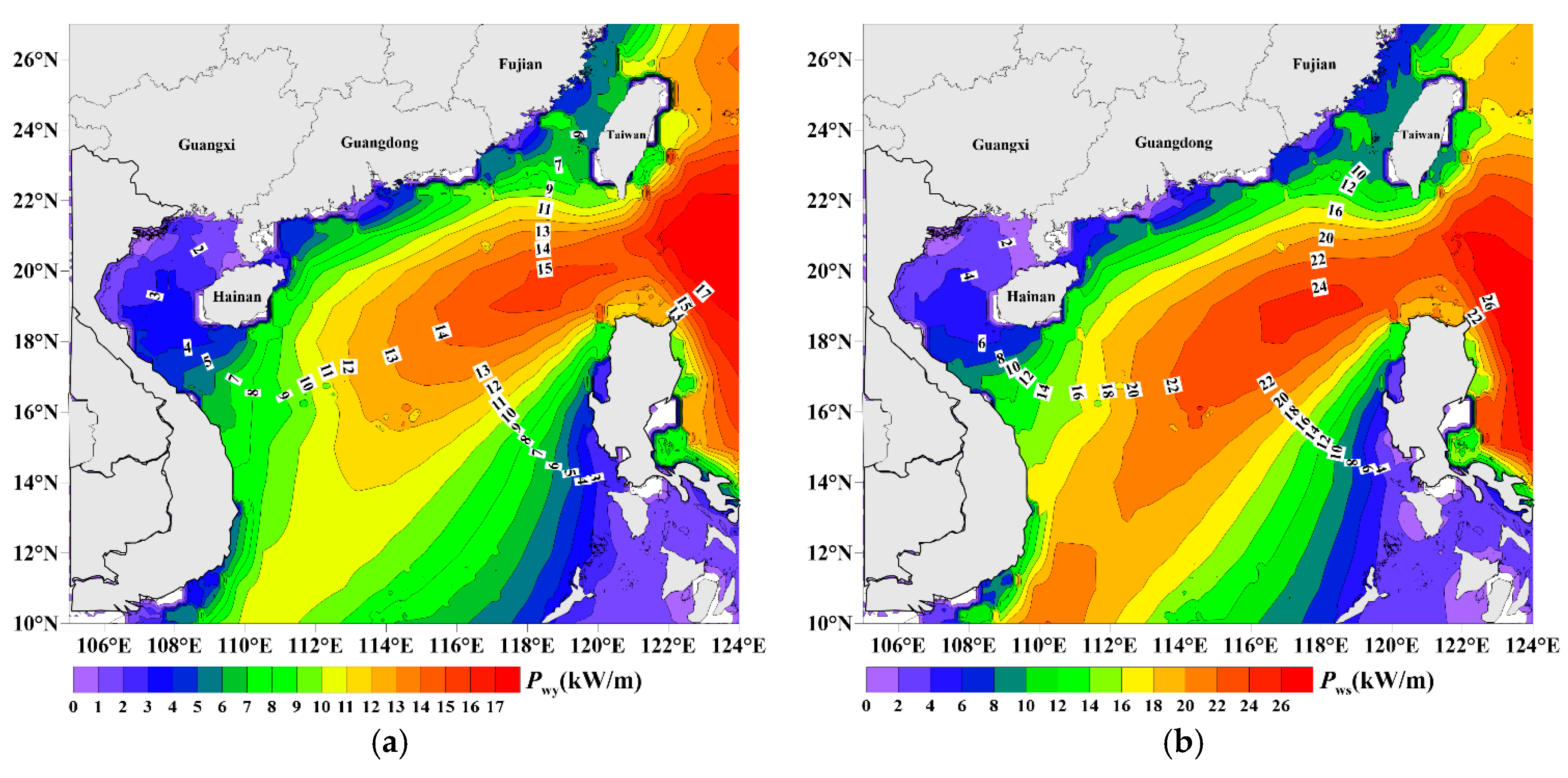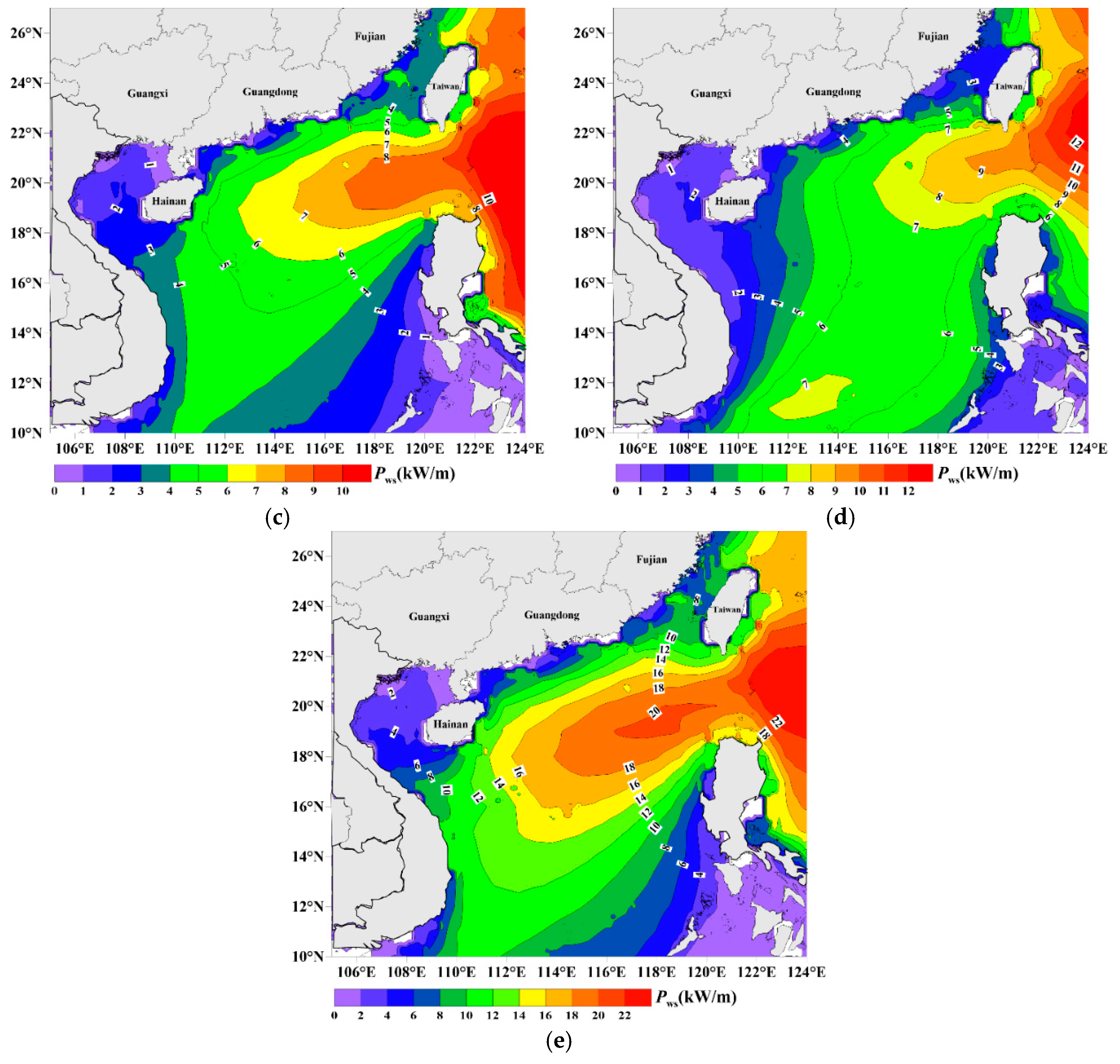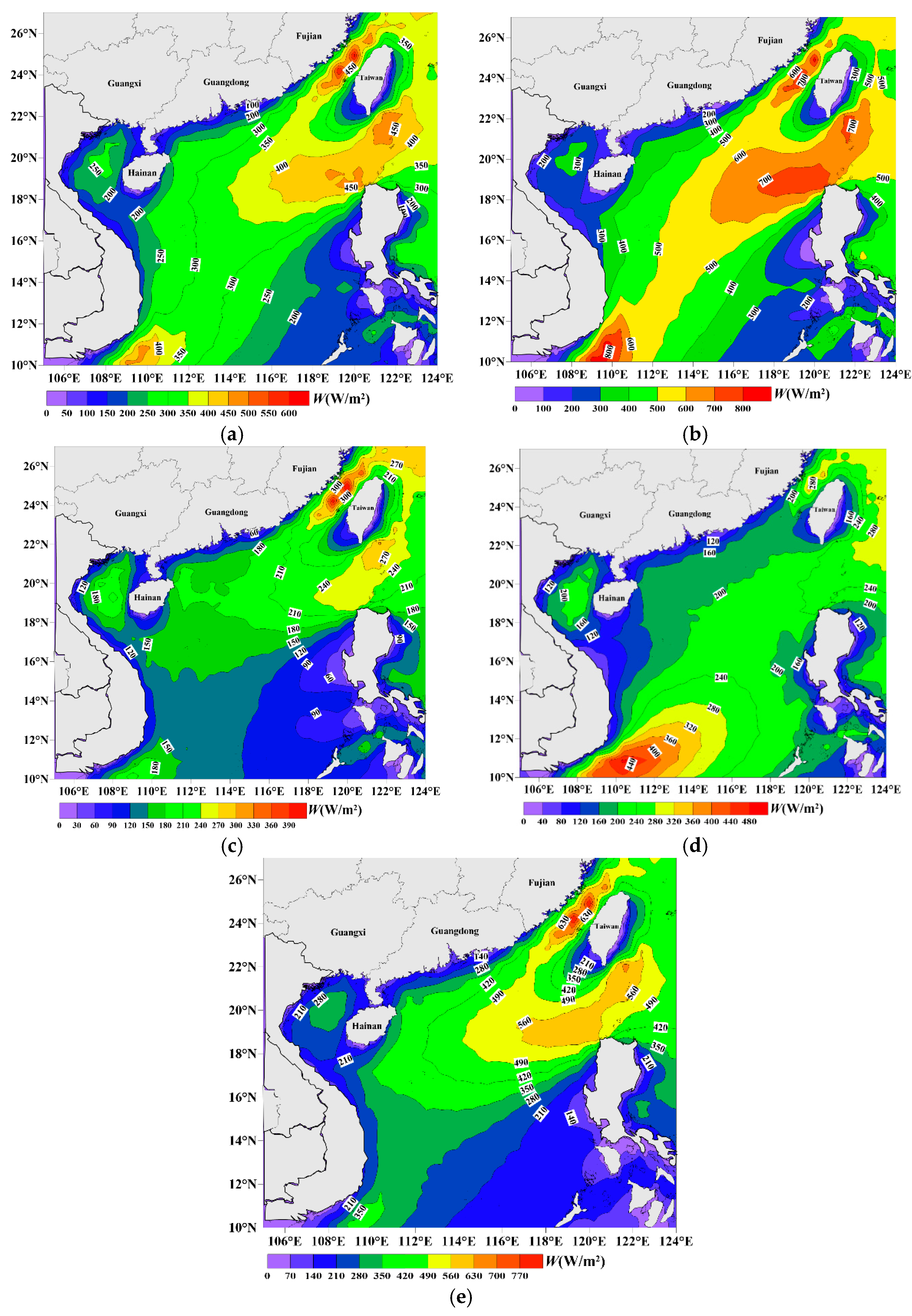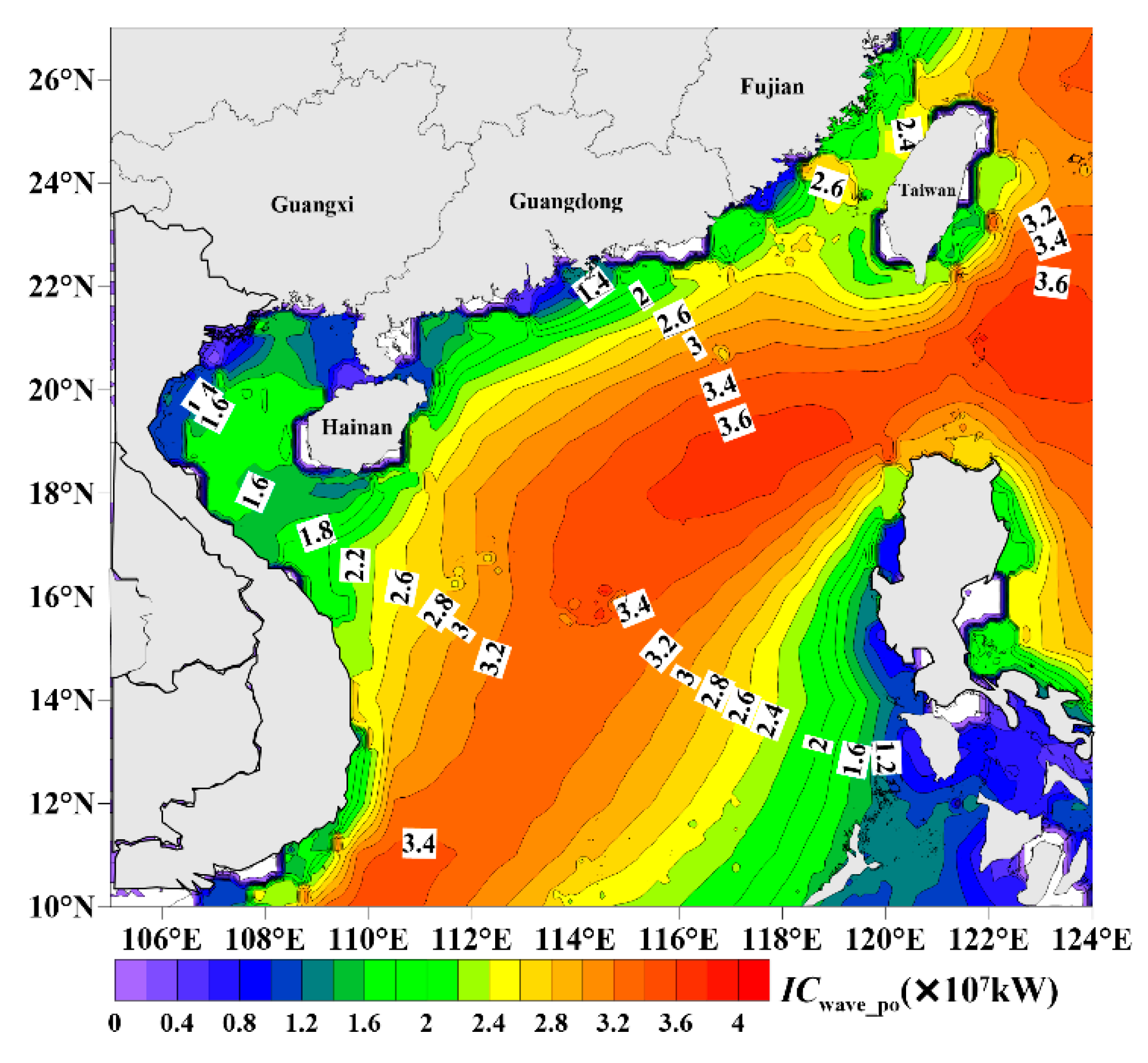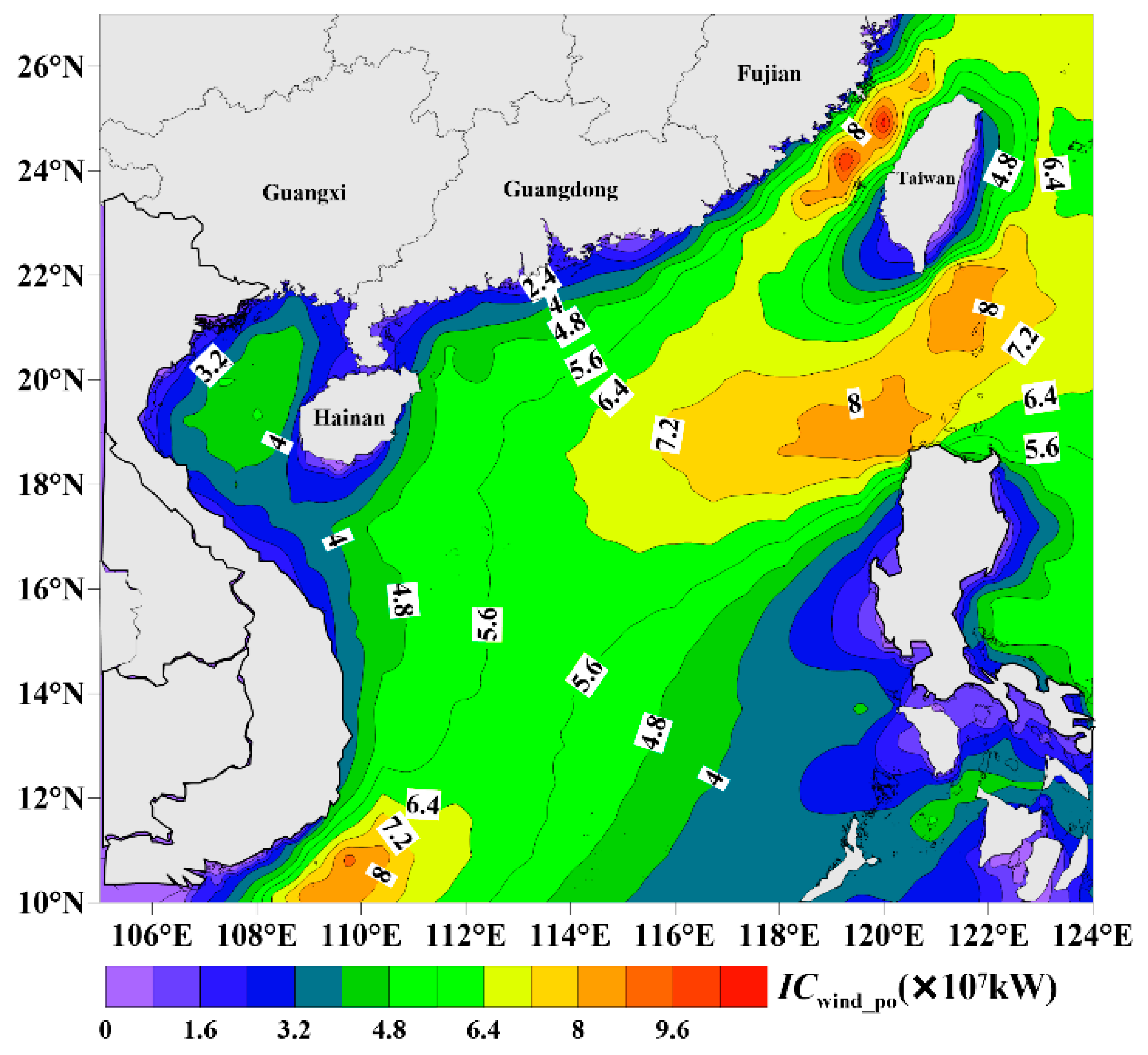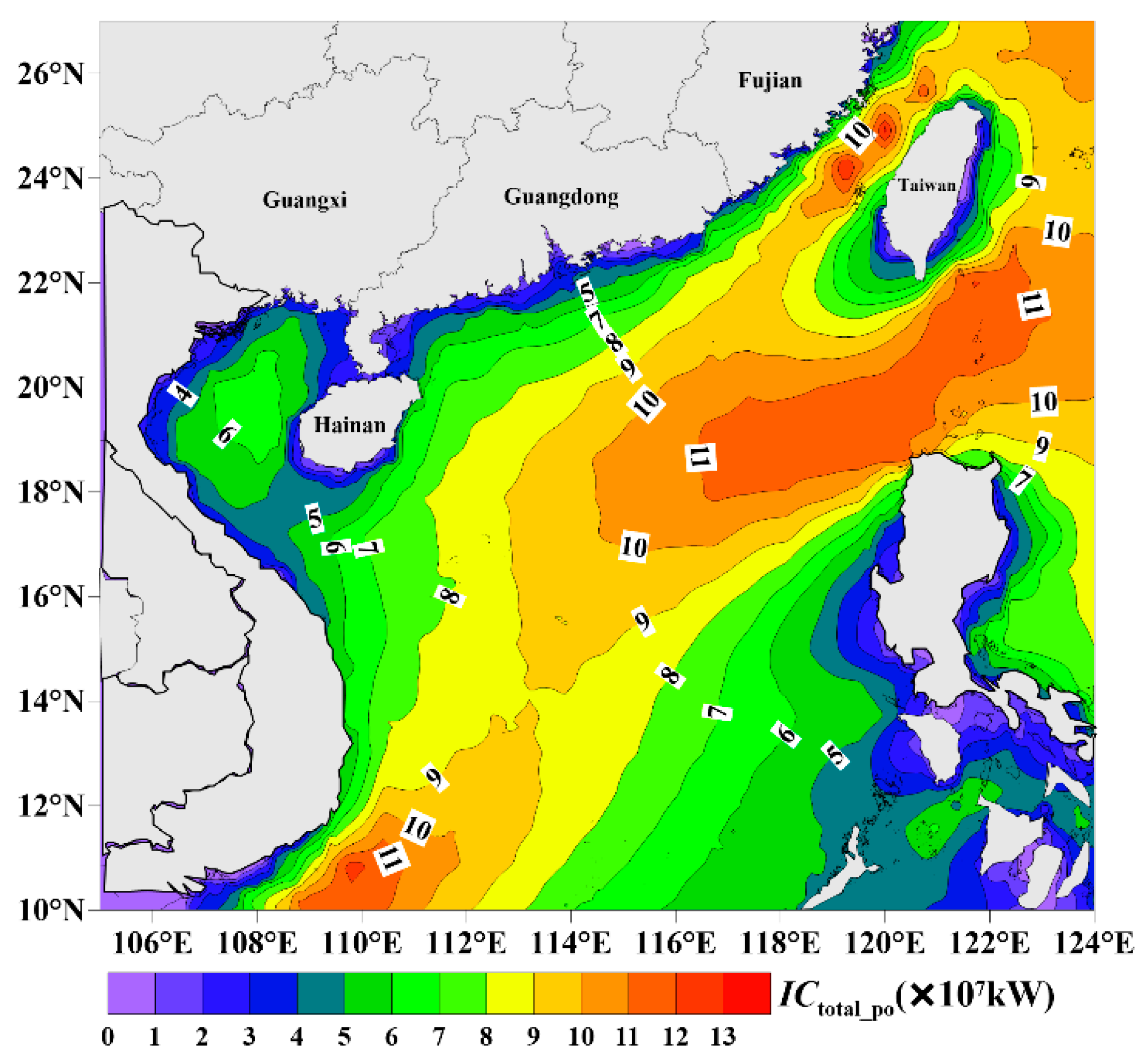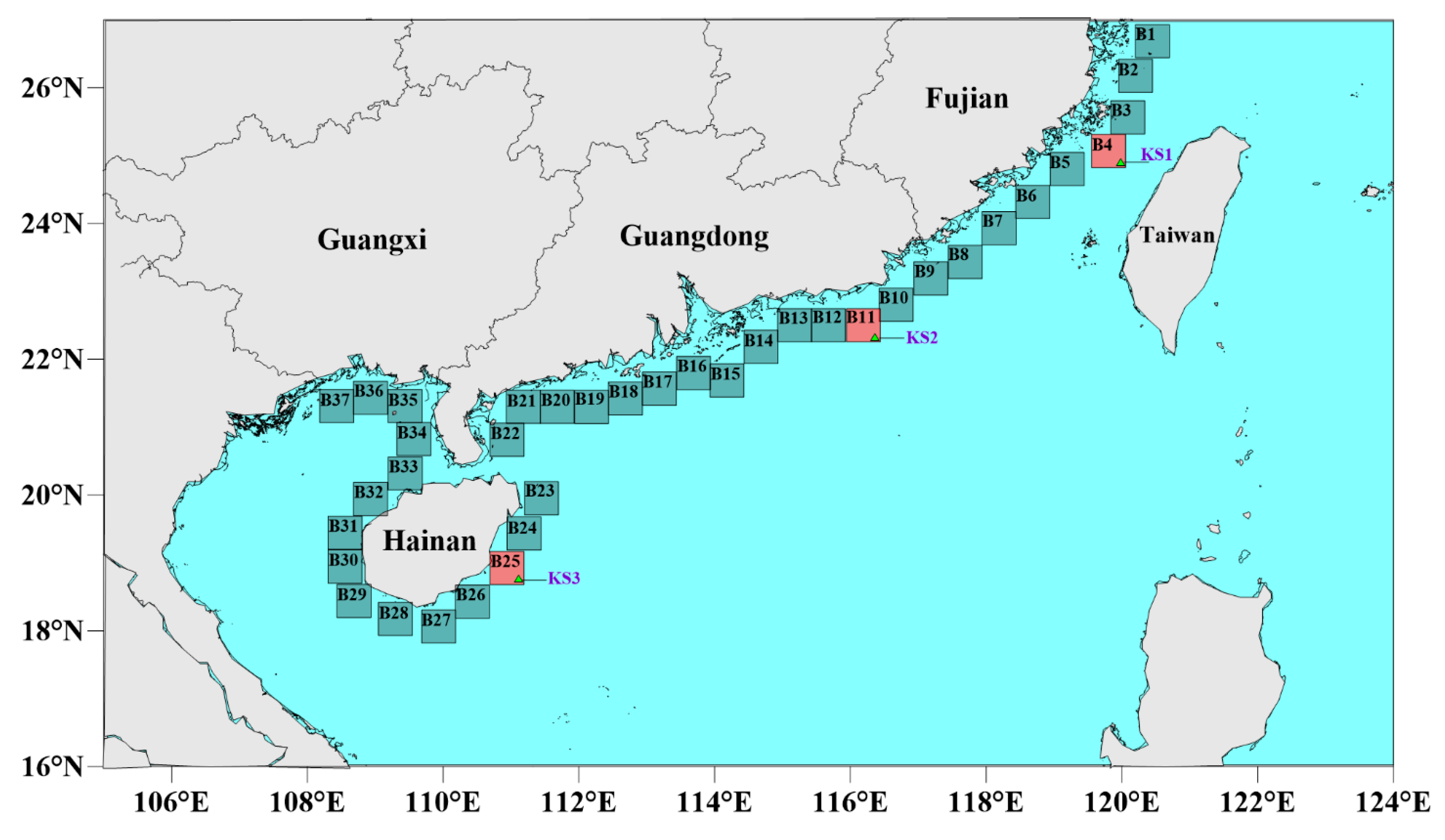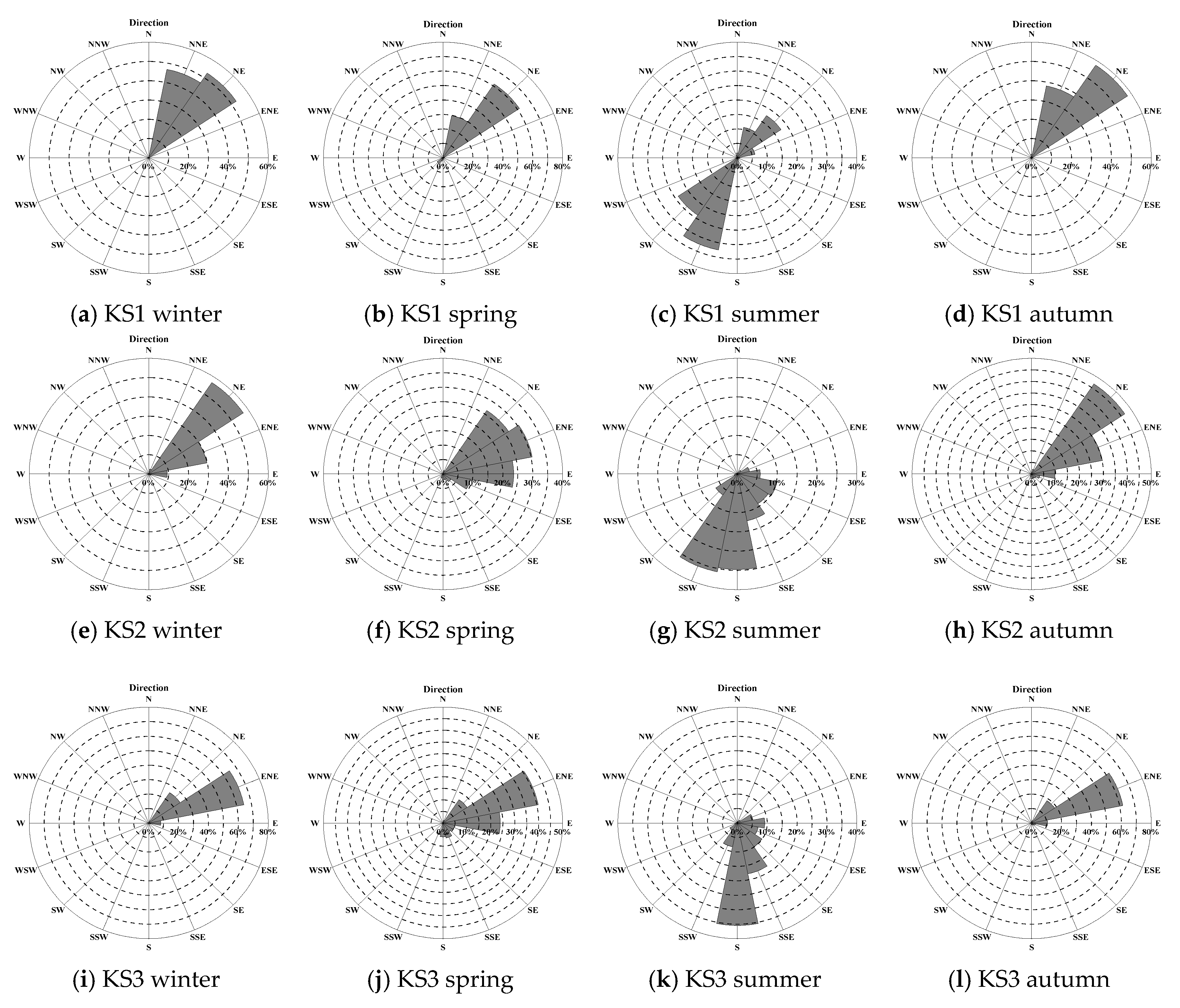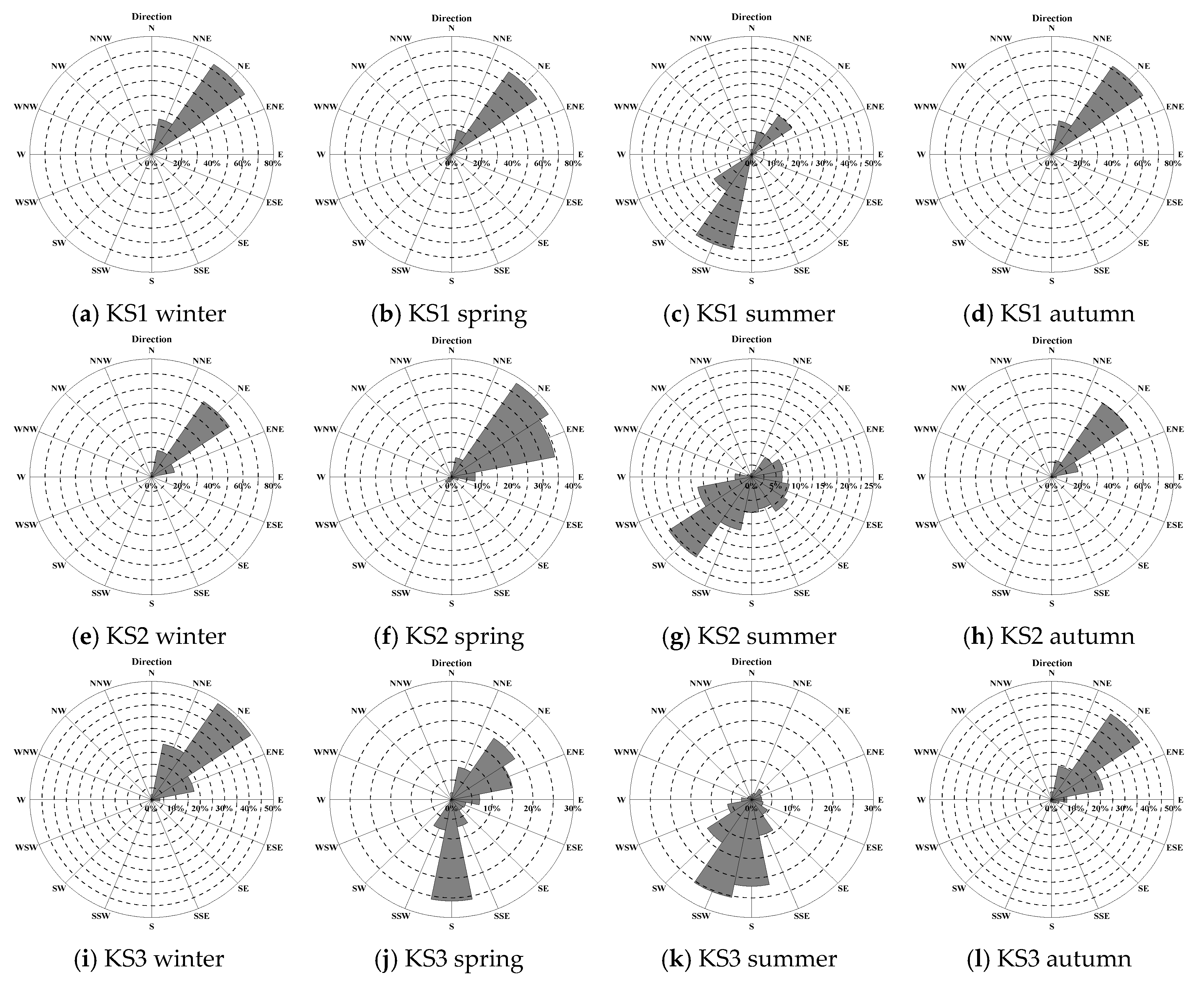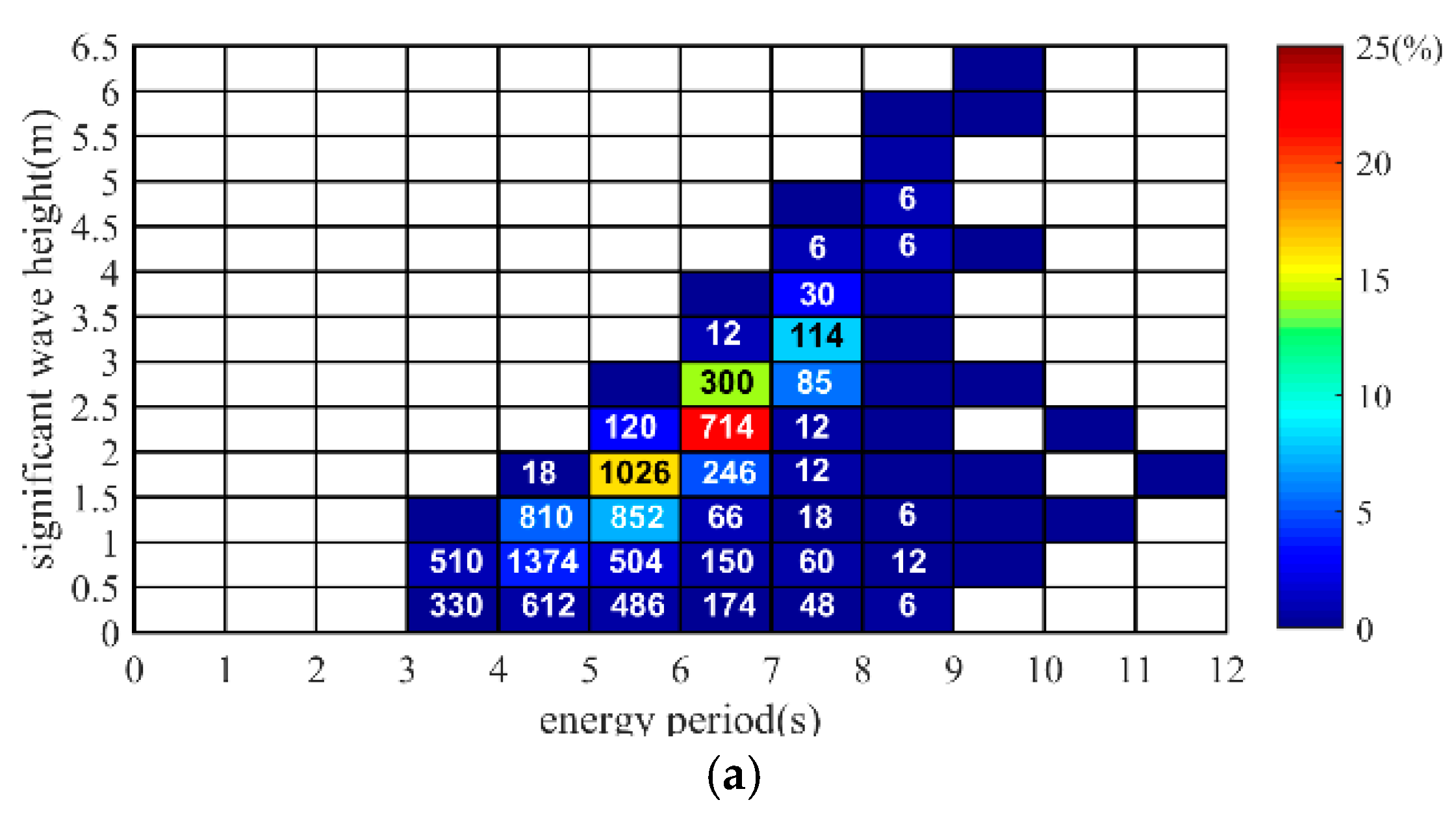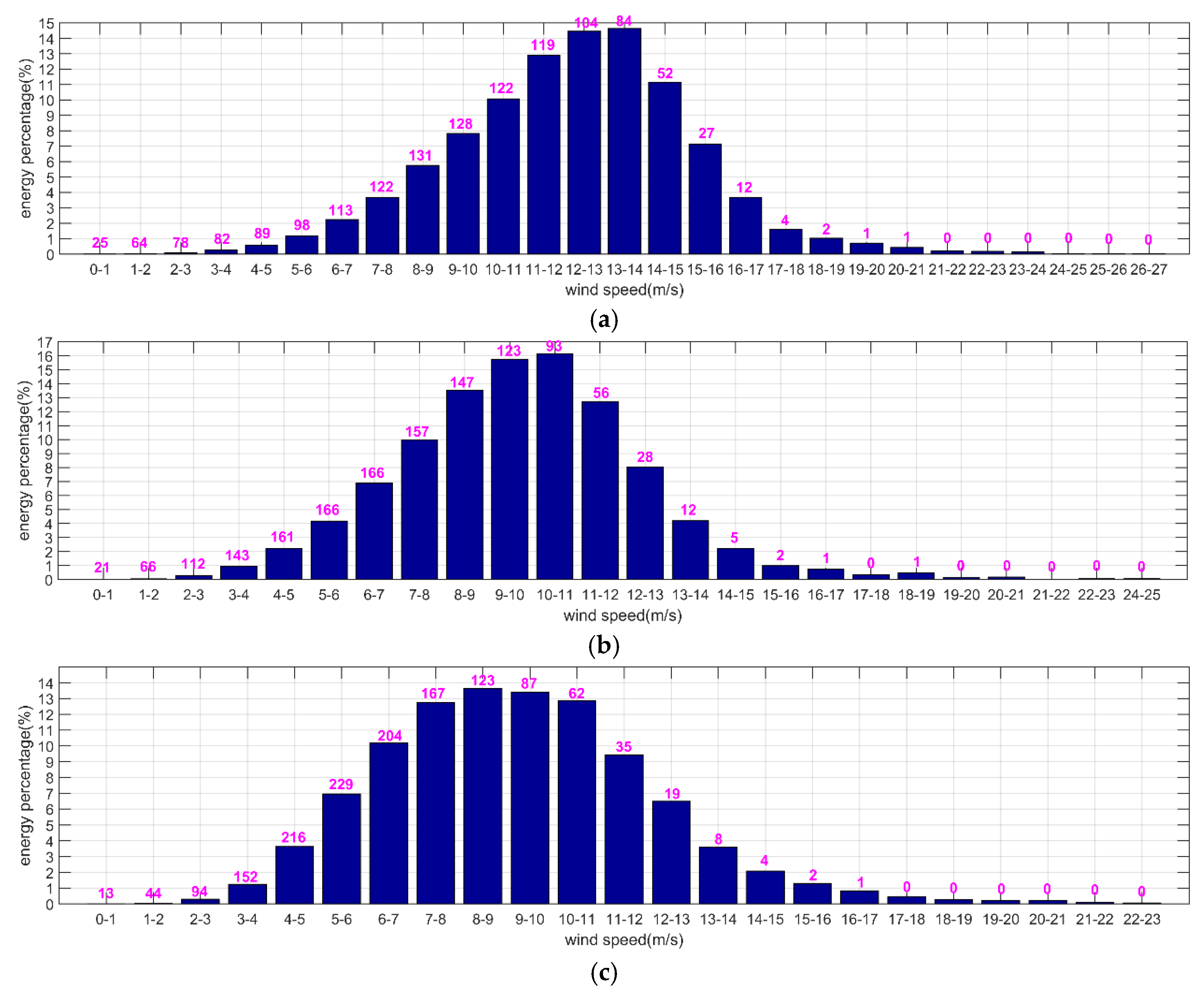Due to limitations of technology level and development cost, the development of wave and wind energy in large-scale offshore areas is relatively difficult. At present, experimental wave and wind energy farms are mainly in nearshore areas, whereas offshore, only trial experiments have been carried out, although related reports have been published for wave and wind energy farms constructed offshore. Therefore, after obtaining the distributions of wave and wind energy in large-scale offshore areas in the South China Sea, we must further elucidate the joint development potential for wave and wind energy in small-scale nearshore sea areas. To this end, key stations were selected in the nearshore sea areas in the South China Sea, and indexes such as power density, potential installed capacity, propagation direction of energy, distribution of energy according to wave conditions or wind conditions, and the economic efficiency and environmental efficiency of energy development were employed to evaluate the joint development potential for wave and wind energy in small-scale nearshore areas in the South China Sea.
3.2.1. Division of Dominant Areas and Determination of Key Stations
In nearshore waters, wave and wind energy assessments are usually carried out based on single stations. We must therefore determine key stations in the area of interest first and assess the energy sources for key stations. Before confirming key stations, promising nearshore areas for the joint development of wave and wind energy must be determined. Therefore, a joint division method for wave and wind energy development potential was established and was used to determine the dominant areas for the joint development of wave and wind energy in nearshore waters in the South China Sea. According to this method, annual average wave power density (
Pwy), annual average effective wave hours (
TEwave, which is the duration of exploitable wave energy and is defined as the annual average duration of waves with 1 m ≤
Hs ≤ 4 m [
26], unit: h), and wave energy potential installed capacity were employed in the wave energy section. In the wind energy section, annual average wind power density (
W), annual average effective wind hours (
TEwind, which is the duration of exploitable wind energy and is defined as the annual average duration of winds with 3 m/s ≤
ws ≤ 25 m/s [
34], unit: h), and wind energy potential installed capacity were employed.
The joint division method is described below:
- (1)
In nearshore waters of the South China Sea, 37 small areas with sizes of 0.5° × 0.5° were selected continuously and are shown in
Figure 10. First, the annual average
Pwy, annual average
TEwave, annual average
ICwave_po, annual average
W, annual average
TEwind and annual average
ICwind_po of every grid were calculated for each small area, and the results for every grid in each small area were taken for averaging and were used as the annual average
Pw, annual average
TEwave, annual average
ICwave_po, annual average
W, annual average
TEwind and annual average
ICwind_po of each small area.
- (2)
The joint quantitative division coefficient (
JQDC) was defined as follows:
from which it can be seen that the potential of joint development increases with increasing
JQDC.
- (3)
According to
JQDC, 5 grades were set. The criteria for the regional division in a general form are shown in
Table 4. From levels 1 to 5, the joint development potentials of wave and wind energy are increasing and are poor, available, good, better and best, respectively. For the range of each index in
Table 4, there are different ranges of values for different areas. Threshold values a–g can be determined using the method in [
31].
- (4)
The criteria suitable for the nearshore waters of the South China Sea of regional division were established. The results are shown in
Table 5.
According to the criteria of regional division established above, we calculated
JQDC and undertook a regional division for 37 small areas with sizes of 0.5° × 0.5° in nearshore waters of the South China Sea. The results are shown in
Table 6. For this paper, 37 small areas were divided into four groups: the nearshore waters of Fujian Province (B1–B8), nearshore waters of Guangdong Province (B9–B22, B34), nearshore waters of Hainan Province (B23–B33), and nearshore waters of Guangxi Province (B35–B37). Because the nearshore waters of Guangxi are located in the Beibu Gulf, where the
JQDC values are lower and the potential for development is also lower, that area was not included in this study. As shown in
Table 6, in the other 3 groups, we selected 1 small area in each that could serve as the dominant areas for the various provinces’ nearshore waters to assess their wave and wind energy development potentials. The dominant area for Fujian nearshore waters is B4 (the grade of area B4 is four, and the
JQDC is 157.16). The dominant area of Guangdong nearshore waters is B11 (the grade of area B11 is four, and the
JQDC is 95.16). The dominant area of Hainan nearshore water is B25 (the grade of area B25 is four, and the
JQDC is 72.49). The three dominant areas are shown in
Figure 10 (red areas).
After determining the dominant areas, we selected key stations in the dominant areas. When selecting the key stations for the nearshore waters, we referred to the
JQDC above and calculated the
JQDC for every grid in the three dominant areas. The results are shown in
Table 7 and show that in each dominant area, the stations with the largest
JQDC, which denote the highest development potentials, were selected as key stations. The information for the stations is shown in
Figure 10 and
Table 7. The three key stations are KS1 (120.000° E, 24.875° N), KS2 (116.375° E, 22.250° N), and KS3 (111.125° E, 18.750° N). In
Table 7, “---” denotes that are no output wave data in this grid; therefore, when calculating the average values for each of the small areas, an average from the grids that included wave data outputs was calculated.
3.2.2. Wave Energy and Wind Energy Development Potential Assessment for the Key Stations
After determining the key stations for wave and wind energy development, indexes including annual average Pwy, annual average W, ICwave_po, ICwind_po, ICtotal_po, the propagation direction of energy, the bivariate distributions of Hs-Te for wave energy and the univariate distribution of ws for wind energy, the performance of well-known wave energy converters, and the economic efficiency and environmental efficiency of energy development were employed to assess wave and wind energy development potential in detail to provide valuable reference information for source development and utilization, converter design and operation.
(1) Overall Condition Analysis for Wave and Wind Energy
Based on 38 years of recent ERA-Interim data, indexes related to energy abundance were calculated for three key stations, and the results are shown in
Table 8. All annual average
Pwy values exceeded 6.09 kW/m at the 3 key stations and were obviously higher than the criterion of exploitable wave energy (when
Pw ≥ 2 kW/m, wave energy resources are usable) but did not reach the abundant level (when
Pw ≥ 20 kW/m, wave energy resources are rich). The annual average
W values all exceeded 243.50 W/m
2 for the three key stations and were higher than the criterion for the abundant level (when
W ≥ 200 W/m
2, wind energy is rich) [
18]. In addition, from the potential installed capacities, at the same station, the wind energy potential installed capacity exceeded the wave energy potential installed capacity, the total potential installed capacities all exceeded 6.75 × 10
7 kW, and the total potential installed capacity for KS1 was the largest. Thus, the wave and wind energy development potentials are higher in the various nearshore dominant areas in the South China Sea.
(2) Wave and Wind Energy Propagation Directions
Research has shown that certain wave energy converters such as oscillating wave surge converters (OWSCs) have the highest absorbance efficiencies when the incident waves are orthogonal to the WECs [
35]. Similarly, incident winds orthogonal to the windward sides of wind energy converters have the highest absorbance efficiencies. Therefore, we must study the propagation directions of wave and wind energy in different periods to adjust the directions of converters to acquire the largest amounts of energy. The propagation directions of wave and wind energy are important factors guiding operational converters. For this reason, in this study, we divided the period by season and calculated the percentages of the energy distributions in each direction, each season and for each key station and drew wave and wind power roses based on 38 years of recent ERA-Interim data.
The results of wave power roses are shown in
Figure 11. The results show that KS1 is located in the Taiwan Strait and is sheltered by land in its northwest and southeast directions, with an obvious narrowing effect. Therefore, as influenced by northeast and southwest monsoons, the propagation directions of wave energy in each season are mainly focused in the northeast and southwest directions. The dominant wave power directions were all NNE-NE (clockwise direction) in winter, spring and autumn, and the wave power accounted for approximately 99.5%, 91.1% and 95.8% of the total wave power, respectively. In summer, the direction of the dominant wave power was SSW-SW, and the wave power accounted for approximately 56.2% of the total wave power. KS2 is located in nearshore waters in the southeast of Guangdong and connects with the West Pacific in the east via the Luzon Strait; this location will be influenced by monsoons and typhoons from the West Pacific in each season. Compared with KS1, the direction of the wave energy rotated eastward in winter, spring and autumn, the direction of the dominant wave power was all NE-E, and the wave power accounted for approximately 96.1%, 80.4% and 86.7% of the total wave power, respectively. In summer, the direction of the dominant wave power was SSE-SSW and the wave power accounted for approximately 63.0% of the total wave power. When influenced by typhoons, incident wave energy was strongly enhanced in the E and SE directions in spring and summer. KS3 is located in nearshore waters east of Hainan, and under the influence of topography, the direction of the wave energy continuously rotated eastward in winter, spring and autumn, the direction of the dominant wave power was NE-E and predominantly ENE, and the wave power accounted for approximately 98.2%, 76.6% and 91.3% of the total wave power, respectively. In summer, the direction of the dominant wave power was SSE-S and the wave power accounted for approximately 53.3% of the total wave power. The results show that wave energy was more concentrated in winter, spring and autumn, which is beneficial for the highest energy absorption.
The results of wind power roses are shown in
Figure 12. Regarding the wind energy for KS1, the direction of the dominant wind power was also always NNE-NE in winter, spring and autumn, and the wind power accounted for approximately 97.8%, 84.2% and 95.1% of the total wind power, respectively. However, compared with wave energy, the percentage of wind energy was strongly enhanced in the NE direction, which was caused by northeast monsoons in those three seasons. In summer, the direction of the dominant wind power was SSW-SW and the wind power accounted for approximately 59.7% of the total wind power. The results show that wind energy was also more concentrated in winter, spring and autumn, which benefits wind energy development. Regarding the wind energy in KS2, the direction of the dominant wind power was NE-ENE in winter, spring and autumn, and the wind power accounted for approximately 76.7%, 72.6% and 77.9% of the total wind power, respectively. In summer, the direction of the dominant wind power was SSW-WSW and the wind power accounted for approximately 43.3% of the total wind power. The regularities of the distribution and cause were similar to those for the wave energy direction distribution. Regarding the wind energy at KS3, the direction of the dominant wind power was mainly NNE-ENE in winter and autumn, and the wind power accounted for approximately 90.5% and 79.5% of the total wind power, respectively, which reflected the influence northeast monsoons. There was a transition between northeast and southwest monsoons in spring such that there were two dominant wind power directions, NNE-ENE and SSE-SSW, and the wind power accounted for approximately 42.4% and 40.8% of the total wind power, respectively. In summer, the direction of the dominant wind power was S-SW and the wind power accounted for approximately 60.5% of the total wind power.
In conclusion, the wave and wind energy propagation directionality was better for the nearshore key stations in various seasons in the South China Sea. In each season, the propagation direction was fixed, which is advantageous for adjusting the directions of wave and wind energy converters. The results can provide important references for mooring wave and wind energy converters in various seasons.
(3) Bivariate Distributions of Hs-Te for Wave Energy and Univariate Distributions of ws for Wind Energy
Bivariate distributions of
Hs-
Te for wave energy can serve as an important index for wave energy assessments that can be used to determine dominant wave condition, which makes a dominant contribution to total wave energy density and can be an important index for wave energy converter (WEC) design. In addition, this index is a basic parameter for assessing the power generation performance of WECs, which can be represented with a scatter diagram [
36]. Referring to the above index, the univariate distribution of
ws for wind energy can also be an important index for wind energy assessments that can be used to determine dominant wind conditions that make a dominant contribution to total wind energy density and can be an important index for wind energy converter design.
In order to grasp bivariate distributions of
Hs-
Te for wave energy in each key station, based on the ERA-Interim data over the last 38 years, using an
Hs interval of 0.5 m and a
Te interval of 1 s, we calculated the percentage of the total wave energy density (the mean of the sum of
Pw multiplied by the number of hours in a year in MWh/(m·year)) under each wave condition to the total wave energy density under all wave conditions [
25,
31]; the results are shown in
Figure 13. In the figure, the color code denotes the percentage and the numbers denote the annual average total number of hours for which particular sea states occurred each year. The results show that the dominant wave condition at station KS1 had
Hs values of 0–3.5 m and
Te values of 4–8 s and the wave energy accounted for 92.79% of the total wave energy density. At station KS2, the dominant wave condition had
Hs values of 0.5–3.5 m and
Te values of 5–9 s and the wave energy accounted for 87.60% of the total wave energy density. At station KS3, the dominant wave condition had
Hs values of 0.5–3.5 m and
Te values of 4–9 s and the wave energy accounted for 87.35% of the total wave energy density. The dominant wave conditions in the key nearshore stations in the South China Sea were the same and thus can serve as an important basis for the design of effective wave conditions of WECs.
In addition, the number of hours can help us understand the occurrence of particular wave condition each year which is meaningful for the design of WECs. The results show that the number of hours under a wave condition with an Hs value of 0.5–1.0 m and a Te value of 4–5 s at station KS1 was the highest at 1374 h. The number of hours at a wave condition with an Hs value of 0.5–1.0 m and a Te value of 6–7 s at station KS2 was the highest at 1104 h, and the number of hours at a wave condition with an Hs value of 0.5–1.0 m and a Te value of 5–6 s at station KS3 was the highest at 1362 h. Regarding the wave conditions at each key station, the Hs values were all 0.5–1.0 m for the majority of hours. However, the ratio of the wave energy under the most common wave conditions to the total wave energy density was not the highest. At stations KS1 and KS2, the wave conditions with the highest ratio of the total wave energy density were an Hs value of 2.0–2.5 m and a Te value of 6–7 s. At station KS3, the wave conditions with the highest ratio of the total wave energy density were an Hs value of 2.0–2.5 m and a Te value of 7–8 s. The annual average number of hours under those wave conditions were 714, 612 and 456 h for stations KS1, KS2 and KS3, respectively. From the above results, number of hours of optimal wave conditions was not necessarily related to the contribution to total energy.
The bivariate distributions of
Hs-
Te for wave energy have important meaning for wave energy development and utilization. Rusu and Soares have indicated that actual wave power yield depends on the particular WEC device as rated by its wave power generation because each technology has different operational ranges and different efficiencies under various sea states [
37]. Contestabile et al. constructed an optimal configuration assessment in terms of the financial returns of the Overtopping BReakwater for wave Energy Conversion (OBREC) [
38]. Vannucchi and Cappietti assessed the performances of 6 state-of-the art WECs in Italian nearshore waters [
39]. Silva et al. evaluated the feasibility of different wave energy converting technologies in Portugal’s nearshore waters [
36]. Rusu assessed wave energy conversion efficiency in various coastal environments [
40]. For the present paper, we employed well-known WECs that were used in the past for similar studies and are well accepted among academics to find suitable WECs for the nearshore waters of the South China Sea. Additionally, the electricity generation performance of well-known WECs in the three key stations in the nearshore waters of the South China Sea were evaluated. Considering the water depths all exceed 50 m, we selected 3 WECs that are suitable for 50 m and greater water depths: AquaBuoy (>50 m) [
41], AWS (>50 m) [
42] and Pelamis (>50 m) [
43]. Indexes including mean power output (
Pe, kW), capacity factor (
Cf, %) and relative capture width (
Rcw, %) were employed to evaluate the performances of the WECs. The calculation methods are as follows [
31,
39]:
where nT is the number of
Te classes, and nH is the number of
Hs classes.
Pij is the power output of the device, which originates from the power matrix for the specific WEC. The power matrices were collected from the open literature [
36,
44].
fij is the occurrence frequency for various sea states, which was collected from scatter diagrams shown in
Section 3.2.2 (3). The rated powers (units: kW) are the rated powers of the WECs. The rated powers of the different WECs were 250 kW (AquaBuoy), 2000 kW (AWS), and 750 kW (Pelamis).
Cw is capture width (m) and can be calculated by:
main_dim
ension is the main dimension of a WEC. The main dimension of AquaBuoy is 20 m [
41], that for AWS is 144 m [
45], and that for Pelamis is 180 m [
46].
According to the method above and the ERA-Interim wave field data from 1979–2016, we calculated the mean power output, capacity factor and relative capture width. The results are shown in
Table 9. From the results, for the 3 key stations,
Pe and
Cf were the highest when using the Pelamis WEC, and the Pelamis WEC apparently is the best suited WEC when considering these two indexes. However, when considering
Rcw, AquaBuoy apparently is the best suited WEC because
Rcw was highest when it was used. The main reason for this result is that AquaBuoy’s dimensions are relatively small, differing by an order of magnitude from those of the AWS and Pelamis WECs. In addition, from the
Cf results, even for the Pelamis, which had the highest conversion efficiency, the
Cf values for the 3 key stations were no greater than 10%. The conversion efficiency was still lower. The results show that the well-known WECs were not suitable for wave energy development in the nearshore of the South China Sea. We must consider the distributions of wave conditions in the area of interest and design power matrix for WECs and develop more suitable WECs for this area to improve conversion efficiency. This work will be carried out in our future work.
Based on the ERA-Interim data over the last 38 years and using a
ws interval of 1 m/s, we calculated the percentage of the total wind power density (the mean of the sum of
W multiplied by the number of hours in a year kWh/(m
2·year)) under each wind speed to the total wind power density under all wind speeds; the results are shown in
Figure 14. In the figure, the horizontal axis denotes the range of wind conditions, the vertical axis denotes the percentage of energy, and the number denotes the annual average number of times under each wind condition. The results show that the dominant wind condition at station KS1 had
ws values of 6–17 m/s, and the wind energy accounted for 93.49% of the total wind energy density. At station KS2, the dominant wind condition had
ws values of 4–15 m/s and the wind energy accounted for 95.75% of the total wind energy density. At station KS3, the dominant wind condition had
ws values of 4–15 m/s and the wind energy accounted for 94.98% of the total wind energy density. At each key station, wind energy was concentrated in the
ws range of 4–17 m/s. Wind energy was scarce for low wind speeds of
ws < 4 m/s and for high wind speeds of
ws > 17 m/s.
In addition, the number of occurrences of wind conditions can help us understand the occurrence of particular wind condition each year which is meaningful for the design of wind energy converters. The results show that the number of occurrences of wind conditions with ws values of 8–9 m/s at station KS1 was the highest, at 131, but the ratio of the wind energy under the most common wind conditions to the total wind energy density was not the highest. The wind condition with the highest ratio of the total wind energy density was that with a ws value of 13–14 m/s, for which the annual average number of occurrences was 84. The number of occurrences of wind conditions with ws values of 5–6 m/s and 6–7 m/s at station KS2 was the highest, at 166, but the ratio of the wind energy under the most common wind conditions to the total wind energy density was also not the highest. The wind condition with the highest ratio of the total wind energy density was that with a ws value of 10–11 m/s, and the annual average number of occurrences was 93. The number of occurrences of a wind condition with a ws value of 5–6 m/s at station KS3 was the highest, at 229, but the ratio of the wind energy under the most common wind conditions to the total wind energy density was also not the highest. The wind condition with the highest ratio of the total wind energy density was that with a ws value of 8–9 m/s, and the annual average number of occurrences was 123. According to the above results, the number of occurrences of wind condition was not necessarily related to the contribution to total energy. At each key station, the medium wind speed provided the maximum contribution to the total wind energy density, and the number of occurrences of medium wind speeds was also maximum. Therefore, wind energy in the nearshore South China Sea is mainly provided by winds of medium wind speeds.
(4) Economic Benefit and Environmental Benefit Assessment for Wave and Wind Energy Development
When assessing wave and wind energy potential, except for energy distribution, we must also assess the economic and environmental benefits of energy development to provide useful information for project decision makers. Regarding economic benefit, in the wave energy section, the annual average generated energy per km of wavefront length (
Ewave_mean, unit: kWh/km/a) was employed, calculated by:
and in the wind energy section, the annual average generated energy per km
2 area (
Ewind_mean, units: kWh/km
2/a) was employed, calculated by:
where
Ewave_mean and
Ewind_mean are the theoretically produced energies in a specific length and area. However, Contestabile et al. indicated that economic and environmental analyses, generally speaking, should refer to real produced energy and not to theoretically produced energy. This potential produced energy takes into account wave-to-wire efficiency or wind-to-wire efficiency [
47]. Therefore, in this paper, we considered an average efficiency of the three WECs and an average efficiency of the wind generator and calculated the potential produced energy for wave energy (
Ewec_mean, unit: kWh/km/a) and wind energy (
Eturb_mean, unit: kWh/km
2/a). For a generic WEC, the overall averaged efficiency was 16.5%, and the maximum energy derived from a wind generator was only 59% of the available wind kinetic energy [
47]. Based on 38 years of recent ERA-Interim data, the theoretically produced energy and the potential produced energy for wave and wind energy were calculated for the 3 key stations. The potential produced energy was then converted to saved total raw coal quantity (unit: ton/a) to reflect the economic benefits for wave and wind energy development. The reduced total carbon dioxide (unit: ton/a) was calculated after developing the wave energy from the annual average per km of wavefront length and the wind energy from the annual average per km
2 of area to reflect the environmental benefit from wave and wind energy development. Each index is shown in
Table 10.
The results show that the economic and environmental benefits from the joint development of wave and wind energy were higher at key stations in the nearshore South China Sea. For the small areas of each key station, the annual average joint potential produced energies that all exceeded 12.7 × 108 kWh and the generating capacities were higher. Wave energy and wind energy can provide stable energy supplies for coastal cities, islands and oil platforms, for example. The economic benefit is remarkable. In addition, the annual average saved total raw coal quantity exceeded 150,000 tons, and the reduced total carbon dioxide exceeded 400,000 tons. The environmental benefit is also remarkable.
